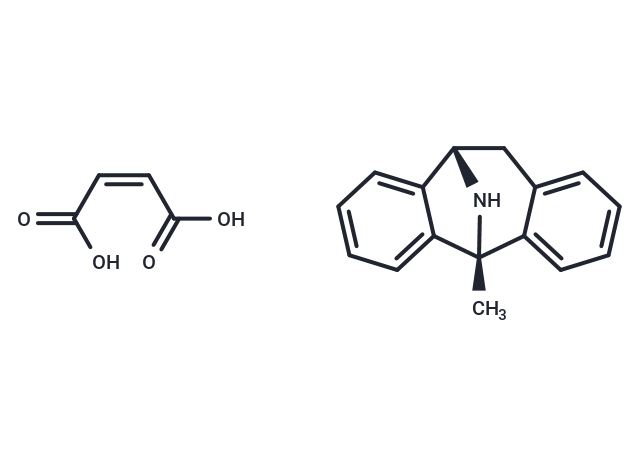Shopping Cart
- Remove All
 Your shopping cart is currently empty
Your shopping cart is currently empty

(-)-Dizocilpine maleate ((-)-MK 801 (Maleate)) is a potent, selective, and non-competitive NMDA receptor antagonist, with a Kd of 37.2 nM in rat brain membranes.

| Pack Size | Price | Availability | Quantity |
|---|---|---|---|
| 10 mg | $43 | In Stock | |
| 25 mg | $74 | In Stock | |
| 50 mg | $122 | In Stock | |
| 100 mg | $228 | In Stock | |
| 1 mL x 10 mM (in DMSO) | $48 | In Stock |
| Description | (-)-Dizocilpine maleate ((-)-MK 801 (Maleate)) is a potent, selective, and non-competitive NMDA receptor antagonist, with a Kd of 37.2 nM in rat brain membranes. |
| Targets&IC50 | NMEA:Kd:37.2nM |
| In vitro | Neurophysiological studies in vitro, using a rat cortical-slice preparation, demonstrates a potent, selective, and noncompetitive antagonistic action of dizocilpine on depolarizing responses to N-Me-D-Asp but not to kainate or quisqualate. The potencies of phencyclidine, ketamine, SKF 10047, and the enantiomers of dizocilpine as N-Me-D-Asp antagonists correlate closely (r = 0.99) with their potencies as inhibitors of [3H] dizocilpine binding. This suggests that the dizocilpine binding sites are associated with N-Me-D-Asp receptors and provides an explanation for the mechanism of action of dizocilpine as an anticonvulsant. |
| In vivo | All the control rats have severe permanent neurological deficits after ischemic spinal cord injury (ISCI), whereas the dizocilpine–treated rats have statistically (P < .05) better neurological outcome and good recovery. Histopathology reveals severe neuronal necrosis in the lumbar gray matter of control rats, whereas dizocilpine–treated rats show mild injury. These results demonstrate that a single dose of dizocilpine given before ISCI provides significant neuroprotection. |
| Kinase Assay | In vitro binding assays:For in vitro binding assays, cerebral cortices from male Sprague-Dawley rats (200-300 g) are homogenized in 9 volumes of ice-cold sucrose by nine strokes with a Teflon/glass homogenizer at 500 rpm. The homogenate is centrifuged for 10 min at 1000 x g, and the supernatant is recentrifuged at 10,000 x g for 20 min at 4 ℃. The pellet is suspended in assay buffer and incubated for 20 min prior to final centrifugation at 10,000 x g for 20 min at 4 ℃. The pellet is resuspended in assay buffer (70 ml per gram of original tissue). Binding of [3H] dizocilpine is measured by incubating 750 ul duplicate aliquots of this crude membrane suspension (=0.75 mg of protein) with 100 ul of buffer containing displacer or of buffer alone (total binding), 100 ul of 50 nM [3H] dizocilpine, and 50 ul of buffer for 60 min at 23 ℃. Nonspecific binding is defined by unlabeled dizocilpine. Incubation is terminated by rapid filtration through Whatman GF/B filters, which are washed immediately with two 5-ml portions of ice-cold assay buffer in a Brandel M 24-R cell harvester. The time required for the complete filtration and washing procedure is less than 10 sec. Radioactivity on the filters is determined by liquid scintillation counting in standard vials with 10 ml of Hydrofluor at 41% counting efficiency. |
| Cell Research | Cell lines: mixed neuronal/glial cell culturesConcentrations: 10 μMIncubation Time: 30 minutesMethod: Primary mixed neuronal/glial cultures are prepared from fetal rat brains. Mature cultures are exposed to dissolved isoflurane [0.4 mM (1.8 minimum alveolar concentration) or 1.6 mM (7 minimum alveolar concentration)] or dizocilpine (10 μM), and NMDA (0 or 3 μM) at 37 ℃ for 30 minutes. Apoptosis is assessed using terminal-deoxy-nucleotidyl end-nick labeling oligonucleosomal DNA fragmentation enzyme-linked immunosorbent assay, and caspases-3 and -9 activation assays. |
| Animal Research | Animal Models: ischemic spinal cord injury medelFormulation: N/ADosages: 1 mg/kgAdministration: IV |
| Alias | C13737, (-)-MK 801 Maleate, (-)-MK 801 (Maleate) |
| Molecular Weight | 337.37 |
| Formula | C20H19NO4 |
| Cas No. | 121917-57-5 |
| Smiles | OC(=O)\C=C/C(O)=O.C[C@@]12N[C@@H](Cc3ccccc13)c1ccccc21 |
| Relative Density. | no data available |
| Storage | Powder: -20°C for 3 years | In solvent: -80°C for 1 year | Shipping with blue ice. | ||||||||||||||||||||||||||||||||||||||||
| Solubility Information | Ethanol: 7 mg/mL (20.7 mM) DMSO: 68 mg/mL (201.55 mM) | ||||||||||||||||||||||||||||||||||||||||
Solution Preparation Table | |||||||||||||||||||||||||||||||||||||||||
Ethanol/DMSO
DMSO
| |||||||||||||||||||||||||||||||||||||||||

Copyright © 2015-2024 TargetMol Chemicals Inc. All Rights Reserved.